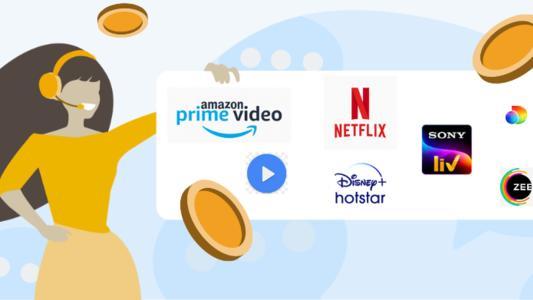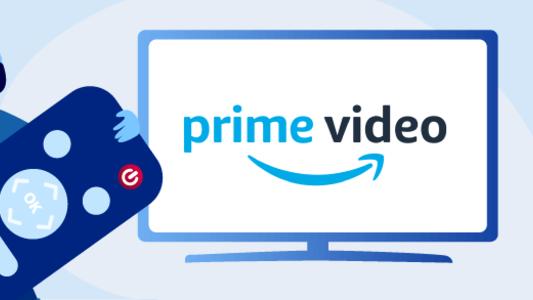How Do OTT Platforms Earn Money?

OTT platforms earn money through a variety of revenue streams, including subscription-based models, advertising, original content creation and licensing, and ancillary revenue sources like merchandising and data monetization. These platforms leverage a combination of user subscriptions, ad revenue, and strategic partnerships to generate income while providing a diverse range of content to consumers.
- OTT- India. Source: Statista.com
- By 2024, revenue in the OTT Video market is forecasted to hit US$4.06 billion.
- The anticipated annual growth rate (CAGR 2024-2029) is 7.43%, indicating a projected market volume of US$5.81 billion by 2029.
- Video Streaming (SVoD) represents the largest market segment, with a market volume of US$2.02 billion in 2024.
- The United States is expected to generate the most revenue globally, reaching US$132.9 billion in 2024.
- The number of users in the OTT Video market is projected to reach 634.3 million by 2029.
- User penetration is forecasted to be 34.1% in 2024 and is expected to increase to 42.2% by 2029.
- The average revenue per user (ARPU) in the OTT Video market is estimated to be US$8.26 in 2024.
How Do OTT Platforms Earn Money?
OTT (Over-the-Top) platforms have revolutionized entertainment consumption by delivering content directly over the internet, bypassing traditional distribution channels like cable or satellite TV. These platforms, including Netflix, Hulu, and Disney+ Hotstar, offer a wide range of content, from movies and TV shows to original series and documentaries, accessible on various devices. Users can enjoy their favorite programs anytime, anywhere, thanks to the convenience of OTT services.
Understanding the revenue models of these platforms is crucial for various stakeholders. Investors rely on this understanding in assessing the financial health and growth potential of OTT companies. Content creators navigate the landscape of OTT monetization opportunities, ensuring their productions are appropriately compensated. Advertisers seek insights into revenue models to strategize campaigns effectively, maximizing their return on investment.

In this article, we'll look into the diverse revenue strategies employed by OTT platforms. From OTT subscription-based models and advertising revenue to original content creation and ancillary revenue streams, we'll explore how these platforms monetize their offerings. By gaining insights into these strategies, readers will develop a comprehensive understanding of the business dynamics behind OTT platforms and their impact on the media industry landscape.
What is a Subscription Based Revenue Model
Subscription-based revenue models are fundamental to the operation of many OTT platforms, wherein users pay a recurring fee for access to content. This model offers subscribers unlimited or limited access to a library of movies, TV shows, original series, and more, typically without advertisements. Subscriptions can be monthly, quarterly, or annually, providing a predictable income stream for platforms while offering flexibility to users in terms of content consumption.
Pricing Strategies and Tiers
- Diverse pricing based on content quality and features.
- Tiered plans: basic, standard, premium.
- Dynamic pricing and promotional offers.
- Designed to cater to different user preferences and budgets.
OTT Monetization: Business Revenue Models
OTT platforms follow one of the four revenue models to make profits. Users will have to watch unskippable advertisements in the middle of their content, which might hinder the movie experience.
Popular OTT (Over-the-Top) revenue models include:
Subscription-Based Model(SVOD)
Users pay a recurring fee for access to content, often with different pricing tiers based on features or content libraries. Examples include Netflix, Disney+, and Amazon Prime Video.
Advertising-Based Model(AVOD)
Platforms offer free or discounted access to content supported by advertisements. Advertisers pay for placements, and revenue is generated based on ad impressions or clicks. Examples include Hulu and YouTube.
Freemium Model
Combining elements of both subscription and advertising models, freemium models offer both free and premium content. Users can access a limited selection of content for free, with the option to upgrade to a premium subscription for additional features or ad-free viewing. Spotify and Crunchyroll utilize this model.
Transactional Model(TVOD)
Users pay for individual pieces of content on a pay-per-view or pay-per-download basis. This model is often used for renting or purchasing movies or TV shows not included in subscription libraries. Examples include iTunes and Google Play Movies & TV.
Hybrid Model
Some platforms combine multiple revenue streams, such as subscriptions, advertising, and transactional purchases, to diversify revenue sources and appeal to different user segments. HBO Max, for instance, offers subscription tiers with and without ads, as well as access to premium content not included in the standard subscription.
OTT Advertising Revenue
Advertising serves as a significant revenue stream for OTT platforms, complementing subscription-based models. By incorporating advertisements into their content, platforms can offer free or discounted access to users while monetizing their viewership. Advertisers leverage the wide reach and engagement of OTT platforms to target specific demographics, maximizing the effectiveness of their campaigns.
Different Advertising Formats Used To Earn Money On OTT
- Pre-roll ads: Short commercials displayed before the start of the main content.
- Mid-roll ads: Advertisements inserted in the middle of video content, typically during breaks or pauses.
- Display ads: Static or interactive banners displayed alongside or within the video player interface.
These ad formats allow platforms to deliver targeted advertising messages to users seamlessly while maintaining the overall viewing experience.
Case studies of OTT Platform Integrating Ads
- Hulu: Hulu offers a hybrid model where users can choose between subscription tiers with or without ads. Ad-supported plans feature commercials during playback, generating revenue while offering lower subscription fees. This approach has attracted a wide user base, balancing revenue from both subscriptions and advertisements.
- YouTube Premium: YouTube Premium provides an ad-free experience for subscribers who pay a monthly fee. However, non-subscribers encounter various ad formats, including pre-roll, mid-roll, and display ads. YouTube effectively monetizes its vast user base through advertising, offering a free option while incentivizing users to upgrade to premium for an ad-free experience.
Challenges and Considerations in Balancing User Experience and Ad Revenue
- Intrusiveness: Excessive or disruptive ads can negatively impact the user experience, leading to viewer dissatisfaction and potential churn.
- Ad fatigue: Overexposure to ads may desensitize viewers and reduce engagement with advertised content.
- Targeting accuracy: OTT platforms must balance the relevance of ads with user privacy concerns, ensuring that targeted advertising remains effective without compromising user data security.
- Competition: OTT platforms face competition from ad-supported free services, requiring them to optimize ad strategies to attract and retain users while maximizing ad revenue.
OTT Original Content and Licensing
Creating original shows, movies, and documentaries is a key revenue strategy for Indian OTT platforms. By offering unique content, platforms like Netflix India and Amazon Prime Video India attract subscribers and keep them engaged. Original content is monetized through subscriptions and merchandise sales, helping platforms grow sustainably.
Licensing Deals and Partnerships
Licensing popular shows and movies, like acquiring rights to Bollywood hits or regional films, strengthens the content library of Indian OTT platforms. Deals, such as Hotstar's partnership with IPL for cricket streaming, enhance their appeal and subscriber base. Strategic collaborations enable platforms to offer exclusive content, giving them a competitive edge.
Impact of Exclusive Content
Exclusive content drives subscriber growth and retention for Indian OTT platforms. Original Indian series and movies, such as those by ALTBalaji or ZEE5, attract viewers seeking local content. Exclusive rights to live sports events, like cricket matches on SonyLIV, also boost subscriber numbers. Indian audiences value access to unique content, making it crucial for platform success.
Risks and Challenges
While original content brings opportunities, it also poses risks. High production costs can strain the finances of Indian OTT platforms, especially smaller ones. Competition for content rights, both domestic and international, is intense, leading to bidding wars and inflated prices. Balancing content investments and managing costs is essential for sustainable growth in India's competitive OTT market.
OTT Freemium and Hybrid Models
Freemium and hybrid revenue models blend free and premium content offerings. They allow users to access a limited selection of content for free while offering additional features or ad-free experiences through premium subscriptions. These models strike a balance between attracting users with free content and monetizing through subscriptions or ads.
In India, platforms like Gaana and Wynk Music offer free access to a wide range of songs with ads, while providing ad-free listening and additional features through premium subscriptions. Similarly, ZEE5 offers both free and subscription-based plans, allowing users to access a selection of content for free and offering premium content for subscribers.
Upselling Strategies To Convert Free Users into Paying Subscribers
Indian OTT platforms employ various upselling strategies to convert free users into paying subscribers. This includes offering free trials, exclusive content, and personalized recommendations to entice users to upgrade. Additionally, platforms utilize discounts and promotions to incentivize users to switch to premium plans, enhancing revenue streams.
Challenges in Maintaining a Balance Between Free and Paid Offerings
One challenge for Indian OTT platforms is maintaining a delicate balance between free and paid offerings. Providing valuable free content attracts users and drives engagement, but excessive free offerings can hinder conversion to paid subscriptions. Platforms must carefully manage content availability, ensuring that premium offerings provide sufficient value to justify subscription fees while keeping free content enticing enough to retain users.
OTT Merchandising and Ancillary Revenue Streams
Merchandising and ancillary revenue streams are additional ways for Indian OTT platforms to generate income beyond subscriptions and ads. These streams include selling merchandise related to content and exploring other avenues such as live events and concerts.
Indian OTT platforms like Disney+Hotstar capitalize on merchandising by offering products related to their popular shows and movies. For instance, they sell merchandise featuring characters from Disney shows, enabling fans to engage further with their favorite content.
Expansion Into Live Events, Concerts, and Other Ancillary Revenue Streams
Some Indian OTT platforms expand into live events and concerts to diversify revenue streams. For example, platforms may organize live screenings of exclusive content or sponsor concerts featuring artists from popular shows. These events provide additional revenue opportunities and enhance viewer engagement.
OTT Data Monetization and Analytics
Indian OTT platforms employ data monetization strategies to leverage user data for generating revenue beyond subscriptions and ads. These strategies involve analyzing user behavior, preferences, and demographics to offer targeted advertising, personalized content recommendations, and valuable insights to advertisers.
Popular Indian OTT Platforms And Their revenue Models
Popular Indian OTT platforms like Netflix, Disney+Hotstar, Amazon Prime Video,ZEE5, and YouTube Premium, Mx Player and others primarily generate revenue through subscription-based models, offering users access to a vast library of content for a monthly or annual fee. Also, these platforms supplement their revenue streams through advertising, live sports broadcasting, premium content licensing, and strategic partnerships with brands and advertisers.
How Netflix Earns Money?
- Netflix earns money primarily through subscription fees paid by its subscribers. Here's how:
- Subscription-Based Model
- Global Expansion
- Original Content Production
- Licensing and Syndication
- Partnerships and Collaborations
How Amazon Prime Video Earns Money?
- Amazon Prime Video earns money through the following revenue streams:
- Amazon Prime Membership
- Subscription-Based Model
- Rental and Purchase of Movies and TV Shows
- Advertising
- Amazon Originals
How Disney Plus Hotstar Earns Money?
- Disney Plus Hotstar, a popular OTT (Over-the-Top) platform in India, employs several revenue-generating strategies:
- Subscription-Based Model
- Advertisements
- Live Sports Broadcasting
- Premium Content Licensing
- Partnerships and Sponsorships
How Zee5 Earns Money?
- ZEE5 generates revenue through various channels
- Subscription-Based Model
- Advertising
- Freemium Model
- Content Licensing and Syndication
- Partnerships and Sponsorships
How Mx Player Earns Money?
- MX Player, a popular OTT platform in India, earns money through various revenue streams:
- Freemium Model
- Subscription-Based Model
- Advertising
- Content Licensing and Syndication
Conclusion
OTT platforms employ various revenue strategies, including subscription-based models, advertising, content licensing, and partnerships. These strategies allow platforms to monetize content effectively and generate revenue from diverse sources.
Adaptation and innovation are crucial for OTT platforms to stay competitive in the rapidly evolving landscape. Platforms must continuously evolve their offerings, embrace new technologies, and respond to changing consumer preferences to remain relevant and successful.









